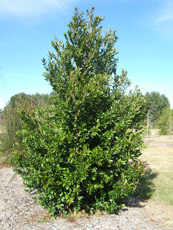Prunus caroliniana (Cherry Laurel)

*Click on picture for more images of this species.
- USDA Hardiness Zone: 8A - 10A
- Mature Height: 25 to 40 ft
- Mature Spread: 20 to 35 ft
- Growth Rate: Moderate to fast
- Availability: Generally available in small sizes
- Drought Tolerance: High
- Salt Tolerance: Moderate
- Light Requirements: Full sun to partial shade.
- Native Origin: Native to Florida.
- Soil Drainage: Needs a well-drained site.
- Foliage: Evergreen tree with no showy fall color.
- Flowers: White, showy, fragrant flowers in the spring.
- Pests: The main insect pests are mites, borers and caterpillars. The main diseases are leaf spot, fire-blight and stem canker.
Description: A dependable North American native, Cherry Laurel is densely foliated with glossy, dark green, evergreen leaves. It can reach 40 feet in height with a 35-foot-spread though is often seen smaller when grown in the open. Cherry Laurel will create a very dense screen or hedge with regular pruning but is also attractive when allowed to grow naturally into its upright oval, dense form. Properly trained to a central leader, the plant could make a good small to medium-sized street tree. The tree usually maintains a good central leader and small-diameter, strong lateral branches following one or two proper prunings before the tree is 8 to 10-years-old. It was widely planted in Texas until the severe drought of the early 1950's weakened them. Many of these weakened trees eventually died from borers. However in Florida drought stricken trees pulled through the 2002 drought very well.
In springtime, tiny, creamy-white showy flowers appear in dense, fragrant clusters and are followed by small, shiny, black cherries which are quite attractive to wildlife. The flowers attract lots of bees and insects. The great quantity of fruit may create a short-term litter problem if the trees are located near a patio or walkway but the fruit is small and washes away quickly. The quick growth and ease of maintenance makes Cherry Laurel ideal for naturalizing and for low maintenance gardens except that hundreds of seedlings can be found beneath the crown each year from germinating seeds. Of course, this would not be a problem in a street tree planting or in an area such as a lawn or highway median which is mowed regularly.
Though the crushed leaves and green twigs give off a delicious maraschino cherry fragrance, they are quite bitter and possibly poisonous. Root systems are often quite shallow but usually they are not aggressive and do not cause problems. Preferring ample moisture while young, Cherry Laurel is otherwise well-suited to sun or shade locations on any average, well-drained soil. Once established, it is salt- and drought-tolerant requiring little or no irrigation. Over-irrigating can cause chlorosis and death, especially in containers. Do not plant in wet, soggy areas. The tree adapts well to soils with high pH. Clay soil is fine as long as water doesn't stand after it rains.
Gainesville Observations: This tree has grown very well after planting. It is easy to prune into any shape including a dominant leader and should make a good small shade tree for dry sites. Trunk develops plenty of caliper when pruned in the typical manner leaving low branches along the trunk. It is hard to know why this tree is not grown more. Fruit could be messy for a while if canopy grows over a hard surface such as a sidewalk.

